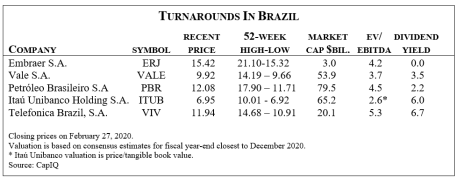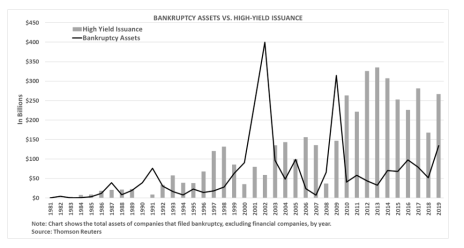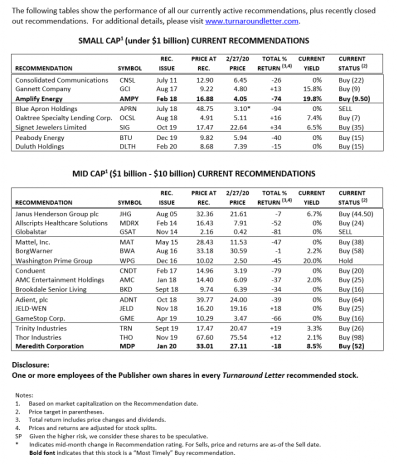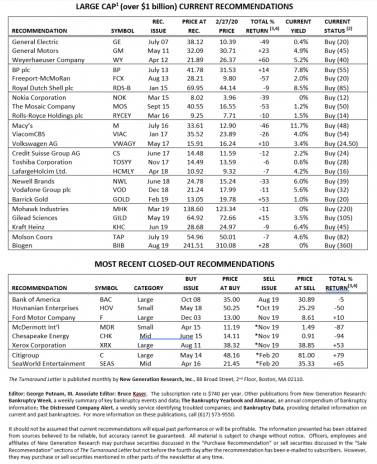Although it is plenty large to be relevant (its economy is the 9th largest in the world and is comparable in size to that of Canada), to many investors Brazil remains a regional backwater mired in political scandals and weak corporate governance. Weak oil prices combined with poor government leadership led to sharp recessions in 2015 and 2016.
However, the country’s fortunes may be turning upward. In this issue, we look at five companies that should benefit from Brazil’s incipient turnaround, and also have appealing turnaround potential in their own right.
Cabot Turnaround Letter 320
Emerging Turnarounds in Brazil
In This Issue:
Brazilian Turnarounds
High Yield Bonds
Comments on the Stock Market
Recommendations:
Buy: DuPont de Nemours (DD)
Ratings Changes and News/Notes
New Rating “Most Timely”
Performance
Although it is plenty large to be relevant (its economy is the 9th largest in the world and is comparable in size to that of Canada), to many investors Brazil remains a regional backwater mired in political scandals and weak corporate governance. Its heavy exposure to commodities helped boost its growth rate to well over 3% earlier in the millennium, but weak oil prices combined with poor government leadership led to sharp recessions in 2015 and 2016. Growth has been positive but lackluster in more recent years.
However, the country’s fortunes may be turning upward: the 2019 election of pro-business president Jair Bolsonaro and the appointment of free marketer and University of Chicago graduate Paulo Guedes as Finance Minister could help unwind Brazil’s bureaucratic institutions and unleash more of its potential. The country’s federal spending is more under control, helping to subdue inflation and allowing interest rates to decline. Growth expectations indicate that the economy will grow at a 2-2½% rate over the next three years.
Listed below are five companies that should benefit from Brazil’s incipient turnaround, and also have appealing turnaround potential in their own right. All trade either directly on the NYSE or as ADRs with plenty of liquidity. While governance is improving, investors should be aware that the state holds “golden shares” in Embraer and Vale, and a controlling stake in Petrobras, adding an element of risk to those stocks.
Embraer (ERJ) – Embraer is the world’s third largest commercial jet manufacturer. About half of its $5.5 billion in revenues are produced from smaller (up to 150 passengers) narrow body aircraft where it is the industry leader. Executive jets (22%), military planes (12%) and related services (19%) comprise the remaining business. Last year, Embraer agreed to sell an 80% stake in its commercial jet business to Boeing for $4.2 billion. If completed, Embraer would receive net proceeds of close to $3 billion – remarkable given its $3.0 billion market cap. The company plans to pay out as a dividend between $1.3 billion and $1.6 billion, then fully repay its debt, resulting in a $1 billion net cash balance. As Embraer’s 20% commercial jet stake is worth an implied $1.0 billion, the market is in essence valuing the company’s executive, military and services businesses at zero. Yet, these operations will produce about $2.6 billion in revenues, close to $100 million in operating profits and should break even on a free cash flow basis in what is likely to be a slow year. Major investor concerns include weak third quarter results, potential for a global economic slowdown and the risk that the Boeing deal won’t be approved. Nevertheless, this stock has intriguing appeal, particularly as the share price is approaching 2009 lows.
Vale (VALE) – With $38 billion in revenues, Vale is the world’s largest producer of iron ore and a major producer of nickel and copper. It also owns major railroads, ports and maritime terminals to deliver its products across the globe. Weakening commodity prices weighed on profits and helped push Vale’s share price down 70% from the 2011 peak. In January, 2019, a mining dam at the company’s Brumadinho facility collapsed, killing 270 people. The CEO was forced out, and the company had to suspend its dividend and share repurchase program to fund over $7 billion in fines and other costs. While Vale continues to face lawsuits, it appears that the financial impact has been mostly contained, although recent findings by an independent committee may lead to additional fines. Fundamentally, fourth quarter results indicate that the company is recovering, with profits and cash flow showing renewed vigor. Vale shares trade at a modest 7.1x earnings and 3.7x EBITDA. Debt net of cash has declined sharply in recent years to $17.8 billion, or about 1x annual EBITDA. While no date has been set, the company anticipates returning to its previous dividend policy which would likely prove generous to shareholders.
Petróleo Brasileiro S.A. (PBR) – With daily production of 3 million barrels of oil (equivalent), Petrobras is comparable in scale to Chevron. While its history (and sizeable state ownership) suggests the company has only tangential regard for shareholders, this appears to be changing for the better. In 2019, the company divested $16 billion of non-core assets to increase its focus on the attractive Buzios offshore oil field, repaid $21 billion in debt, and implemented several new practices to improve its governance and accountability. Large stakes held by government entities are being reduced. At its December investor conference, the company further described its “Mind the Gap” strategy to narrow its oil and gas exploration business, invest $76 billion over the next five years to boost its energy production, sell half of its refining operations, and streamline other operations while improving its overall capital structure. If successfully implemented, Petrobras’ plans should significantly boost its free cash flow, allowing generous increases to its already well-covered dividend. The shares trade at a very reasonable 11x earnings and 4.5x EBITDA.
Itaú Unibanco Holding S.A. (ITUB) – Itaú is one of the largest banks in Latin America, with assets of $415 billion, about the size of PNC Financial (the 8th largest bank in the United States). Also among its assets is its brand, recognized as the most valuable in Brazil. The bank offers a full line of financial services ranging from corporate investment banking, investment management (the largest in Brazil) and insurance to consumer banking and credit cards. About half of the voting shares are controlled by two families who have provided capable oversight and accountability.
The difficult economy previously led to higher loan losses, which now appear to be improving, as has consumer and small business lending. Recent quarterly results indicate that Itau’s prospects, already healthy, are looking up. The bank continues to boost its relevance and efficiency with new digital capabilities, both internally and for its customers. Return on equity reached 23.7%, remarkably high for any bank, particularly with such a strong capital level (13.2% CET1 capital ratio). Itau pays regular monthly dividends, frequently augmented by special dividends, totaling $.71 last year, producing an appealing yield.
Telefonica Brazil S.A. (VIV) – Telefonica Brazil is the country’s largest telecom company, offering a full suite of mobile (under the widely-recognized Vivo brand) and fixed voice, broadband, pay TV and other related services to 94 million customers. Spanish telecom giant Telefonica owns a 29.8% stake. The company’s sizeable investments in its business are paying off: its share of the mobile market (33%) has grown to its highest level in over a decade, while heavy fiber-to-the-home (FTTH) installations lifted that segment’s revenues by 38% recently.
Overall, fourth quarter revenues grew by 2.6% and recurring EBITDA by over 5%. Future FTTH and 4.5G investments across Brazil should help extend its powerful market position, while digitalization and other efficiency initiatives are likely to further expand its profit margins. With its low 5.3x EBITDA valuation, modest debt and attractive 6.7% dividend yield, investors should dial into Telefonica Brazil.
THE SUN MAY BE SETTING ON HIGH YIELD BONDS
As the coronavirus outbreak threatens the record-long economic expansion, and potentially the record-long bull market in stocks, we thought it would be valuable to turnaround investors to comment on the state of the high yield bond market. These bonds carry more sensitivity to economic conditions than those with investment grade credit ratings, as their underlying companies generally need a healthy economy to service their heavier debt burdens.
Over the past ten years, through January, the performance of high yield bonds reflects their position between equities and investment grade bonds. The bonds’ 7.9% annualized rate of return is above the 5.3% rate of higher quality bonds but below the more cyclical 14.0% rate for the S&P500. Comparable maturity U.S. Treasuries have produced a more humble but still generous (for a risk-free instrument) 4.1% rate of return. Historically, these decade-long returns are impressively high.
Investors are well-aware of the driving forces behind these gains: healthy economic growth, supported by chronically low inflation and central banks’ strenuous efforts to reduce interest rates. With yields now reaching record lows (the 10-year U.S. Treasury bond now yields only 1.30%), and credit defaults docile, yield-oriented investors can hardly be blamed for scrambling into high yield bonds as a seemingly low-risk way to capture higher income. But as the widely-used disclaimer reminds us, past performance is not a guarantee of future returns.
The most rewarding time to buy high yield bonds is when conditions are difficult. Useful indicators include attractive yields, wide spreads in yields (compared to Treasuries) and periods with relatively limited new bond issuances.
Currently, however, the market is in the opposite position. High yield bonds trade at an average yield of 5.47%, nearly at their 25-year lows. Further, this yield is at a narrow 4.27 percentage point premium to comparable maturity Treasuries, nearly the thinnest spread in a generation.
For context, in even moderately weak economic conditions, this spread can readily widen to over seven percentage points, and reached nearly 20 percentage points at the peak of the global financial crisis.
With investors voracious appetite for yield, Wall Street has been more than happy to supply the market with higher yielding bonds. Last year, $266 billion of high yield bonds were issued, continuing a decade-long trend of heavy new supply (see chart above). Along with this craving for yield, investors have swallowed bonds with very weak covenant protections, which otherwise would provide better recovery rates in a default.
Not only have public debt markets provided generous high yield financing, but a rapidly growing private credit market has emerged, now almost $800 billion in size. Along with their private equity brethren, these lenders provide funds directly to corporate borrowers, typically for acquisitions. Private acquisition markets reflect the aggressive inflow of funds, with average deal prices approaching a highly-elevated 12x EBITDA. A large proportion of these deals carry leverage above 6x adjusted EBITDA, with the adjustments becoming ever more generous, including cost-savings that have not yet materialized. The high valuations and high leverage have put investors at risk of higher default rates. By some estimates, default rates in a recession can approach 30%.
At their best, most bonds can only provide investors with the principal balance at maturity plus the interim interest payments. With high prices, low yields and limited credit protection, high yield bonds almost appear to be a one-way bet currently: if you succeed you will get your money back. If you’re wrong, you will lose potentially large chunks of your capital. Historically speaking, conditions are likely to go in only one direction: worse.
The market appears to be starting to weigh these risks. Month-to-date returns for February are the opposite of the longer-term pattern: U.S. Treasuries lead with a robust 3.2% return, followed by investment grade corporates (+1.1%), high yield bonds (0.1%) and equities (-3.2%).
For turnaround investors looking at high yield bonds, this is a time to be cautious. Companies with credible business plans and reasonably good prospects may have appealing bonds. But, in general, the high yield sector looks unlikely to continue its strong performance and now carries increased risk. Investors should wait for the cycle to turn downward, then look for bargain prices in distressed bonds and newly emerged post-bankruptcy stocks.
BRIEF COMMENTS ON THE STOCK MARKET
The market’s abrupt drop is one of the fastest declines (only six days) of 10% or more from a record high. Some high-profile individual stocks, including AMD (-25%), Morgan Stanley (-20%) and Tesla (-26%) have seen even sharper declines. Market action today (Friday, February 28th) look weak as well.
Fears related to the economic impact from the spreading coronavirus clearly caught an overpriced, momentum-driven market by surprise. But, while unnerving, the 15% decline (through mid-morning today) from its record high sounds alarming, it mostly just unwinds the sharp gains from last year’s second half. Currently, the S&P 500 index is on par with its August 2019 level.
With these market conditions, it’s important to remember the emotional nature of stock markets. Investors will generally accept risk as long as prices are rising, but the fear of losses can quickly lead to aggressive selling. Traders have a saying that captures this: “stocks take the escalator up but the elevator down”.
We want to emphasize one of our most basic investment beliefs: you shouldn’t try to time the market. Sharp declines make it tempting for investors to trim their stock holdings. And, the reverse is true as well – the market can slide downwards just when you think the coast is clear. Timing the market can lead to financially damaging “whipsaw” investing – bailing just before the market rebounds and then diving back in just prior to a drop.
We encourage investors to stay the course. Check your asset allocations to make sure your portfolio is within your acceptable ranges and consider looking for attractive stocks that are now available at bargain prices. The stock market and our economy have survived and flourished following much worse problems, and we remain confident in their long-term prospects.
Purchase Recommendation: DuPont de Nemours
Background:
DuPont is one of the world’s largest and most highly-regarded specialty chemical companies. Its operations focus on four major business lines, including Electronics and Imaging (17% of revenues), Nutrition and Biosciences (28%), Transportation and Industrial (23%) and Safety and Construction (24%). A new “non-core” segment houses the remaining 8% of revenues.
Founded in 1802 by Éleuthère Irénée du Pont in Delaware to produce gunpowder, the company was forced by a 1907 anti-trust ruling to divest most of its near-monopoly, which led to its expansion into other chemicals. Over the years, DuPont developed iconic materials such as nylon, Teflon, Kevlar, Tyvek, and Dacron polyester. The company’s portfolio has undergone major changes recently, starting with the 2015 spin-off of its performance chemicals unit, named Chemours. In August 2017, the company combined with Dow Chemical in a $130 billion merger of equals, creating DowDuPont, with plans to combine their over-lapping operations into three new companies.
DowDuPont spun off its materials sciences businesses as Dow Chemical in April 2019, followed that June by the spin-off of its agricultural business into a new company called Corteva. The remaining businesses became DuPont. This past December, the company announced an agreement to divest its Nutrition & Biosciences (N&B) division through a tax-efficient transaction with International Foods & Fragrances (IFF).
DuPont shares have fallen steadily since the 2017 merger. Recent fears over the coronavirus and a possible global economic slowdown, particularly in the automotive sector, along with disappointing fourth quarter results and an uninspiring 2020 outlook, have accelerated the losses, with the shares now trading down 41% since the June 2019 spin-off. Furthermore, investors are increasingly worried about the potential liabilities associated with toxic chemicals, primarily PFAS and PFOA. As part of its spin-off, Chemours agreed to indemnify DuPont from these liabilities, but Chemours is now demanding that DuPont either agree to share the cost of the liabilities or return the $4 billion dividend that Chemours paid to DuPont as part of the spin-off.
Analysis:
While DuPont’s near-term outlook may be uninspiring, its 9.2x EBITDA valuation assumes that its future is fairly grim. Yet, DuPont remains a high-quality company with market-leading brands and patented products that generate healthy 26% margins. Diversified across a wide range of industries, its innovations continue to position it well for highly-profitable relevance in emerging applications that include automotive, 5G, semiconductors, water technology and medical applications.
DuPont’s portfolio changes should help highlight some of its hidden value. The deal with IFF valued the N&B operations at a high 18x EBITDA multiple. The accompanying $7.3 billion cash payment to DuPont will help pay down its debt and possibly fund share repurchases. We expect more changes to its portfolio in coming years.
Earlier this month, the company replaced its CEO with Ed Breen, the highly capable executive who led the company’s vast transformation starting in 2015 and previously led the turnaround at Tyco. He will continue as executive chairman, and installed his trusted lieutenant Lori Koch as the new CFO. This important catalyst should accelerate the company’s performance improvement and possibly changes to its portfolio.
While the PFAS/PFOA liabilities appear daunting, they are likely to be contained at a level that DuPont can handle. We believe the new CEO will work toward a reasonable solution.
All-in, shares of DuPont look like a bargain, backed by a high-quality company that generates considerable free cash flow, has an improving balance sheet and led by a highly capable executive.
We recommend the PURCHASE of shares of DuPont (DD) with a $70 price target.
RATINGS AND PRICE TARGET CHANGES
On February 20th, we moved Blue Apron to a SELL. The company will be significantly increasing its marketing spending but it can’t produce the needed funds internally, so it will look for capital through either a dilutive equity raise, a company sale or some other combination. Given Blue Apron’s weak negotiating position, any deal would likely not be financially appealing to current shareholders. While a sale could bring a higher price given the sharp sell-off recently, to recommend APRN as a Buy would mean we think that a purchase, at a much higher price, is a high-probably outcome. We have no way of knowing, other than through pure speculation, when/what price/if a sale would occur.
While satellite communications company Globalstar has recently made incremental improvements to its weak governance and constrained capital structure, it continues to produce losses with limited prospects for meaningful reversal. We are changing our rating from Hold to SELL.
NEWS/NOTES
As expected, Washington Prime Group cut its dividend, with the new rate of $.125/quarter, or half the previous rate. We are now revisiting our Hold rating, as the cut buys the company more time for its turnaround.
AMC Entertainment cut its dividend by 85%, to $.03/quarter, to fund more debt repayments and repurchase shares. The company has authorized a $200 million share repurchase. AMC’s senior executives took a 15% immediate pay reduction for the next three years, in exchange for a one-time grant of deep out-of-the-money shares. We believe the dividend cut makes sense, and we find that the pay cut/share grant indicates that the leadership is willing to back their conviction in the stock’s prospects.
Check out our Friday afternoon podcast and the www.turnaroundletter.com website where we review earnings reports for all Recommended stocks.
NEW RATING: “MOST TIMELY”
In response to numerous requests from subscribers and to highlight the more timely stocks on our Recommended List, we are adding a new rating, “Most Timely”. Stocks with the “Most Timely” rating would include Buy-rated stocks that have, in our view, the most near-term appreciation prospects, driven by their fundamental improvements, attractive valuation and other traits.
This list would be an extension of our “Top Five” list that we do every December, yet would be actively adjusted throughout the year. We may have anywhere from zero to perhaps up to eight stocks on the list at any one time. Like all of our ratings, the “Most Timely” rating is not designed to function as a trading-oriented indicator.
Subscribers, particularly new ones, might find this list to be a good starting point when adding stocks to their portfolios.
Stocks rated “Most Timely” will appear in bold fonts on the Performance pages of the Turnaround Letter. We will also include brief commentary here on the website describing why we believe the stock merits the “Most Timely” rating.
Stocks now rated “Most Timely” include Meredith Corp and Amplify Energy.





